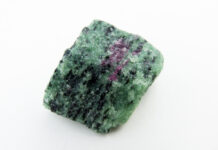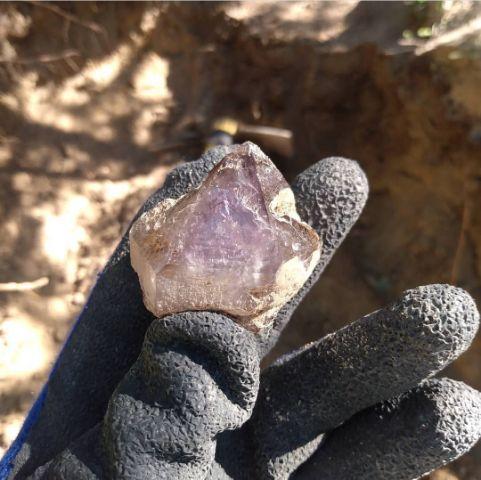
In Crystal Park, Montana, sometimes after a hard rain, the glint of crystals sparkles as they emerge to the soil surface after spending millions of years deep in the earth. Visitors to Crystal Park, Montana, in the Beaverhead-Deerlodge National Forest, stand upon a treasure that amazes rock enthusiasts from around the world.
How Crystal Park, Montana, Formed
“It’s been a long-known local spot for probably 50 or 60 years,” said Paul Senn, a professional prospector and owner of Montana Crystal Miner who grew up in this area. “Crystal Park is really unique, and it will continue to be if it’s treated right.”
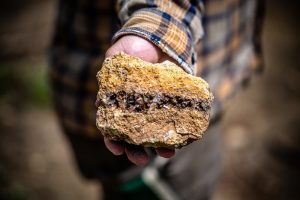
Erik Torgerson, a minerals specialist with the Beaverhead-Deerlodge National Forest, commented that the early history of the area is still a mystery. Miners began filtering into the region in the mid-1800s. In 1969, the Butte Mineral and Gem Club staked a claim, and a couple of years later, the club and the Forest Service agreed to make it a recreational area. That was its standing until 1993 when an executive order made it an official National Forest recreation area. The order was recently renewed for another 30 years.
The story of Crystal Park, Montana, began over 72 million years ago with the subduction of the Pacific Ocean floor beneath the continent. “Liquid rock rises up and finds avenues to travel both vertically and laterally,” explained Rob Thomas, a geology professor at the University of Montana Western in Dillon and coauthor of Roadside Geology of Montana. This is how the magma found its way to Southwest Montana, forming the Pioneer Batholith whose molten granite created the surrounding Pioneer Mountains.
With molten granite between 300 to 600°C, as the rock cooled this super-heated water laden with minerals found its way between fractures in the rock, cooled and crystallized among the widening spaces.
Let There Be Crystals!
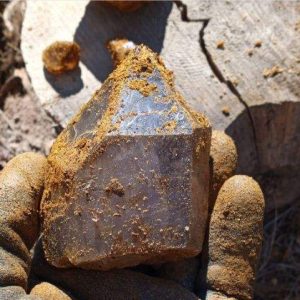
“The fracture in the rock is essentially why Crystal Park, Montana, is here. The vast majority (of crystals) are single terminus,” said Thomas, although he noted there are cases where both points on the end of a quartz crystal grew because it had adequate space between the rocks. “Those are pretty rare but super cool.”
The story doesn’t stop with the formation of the crystals because for millions of years they remained deep within the earth. Thomas explained that this area is a basin and range country, which is being pulled apart. “The western Pioneers have been going up for 17 million years,” he said, while the Bighole, Wise River and Beaverhead regions are dropping.
As the area rises, materials are transported from the region through rain and resulting erosion. “All that rock was stripped away,” he said. Finally reaching the granodiorite, the cooled bedrock of the region, minerals such as mica, which is a sheet crystal that expands when wet, break apart the base rock resulting in granite sand called grus.
“People are screening through the grus to find the crystals that are liberated from the rock,” explained Thomas.
Geological Activity at Crystal Park, Montana Equals Crystals
Because of these millions of years of dramatic geological activity, multitudes of quartz and smoky crystals, as well as amethyst, are found anywhere from on the surface to dozens of meters below the topsoil.
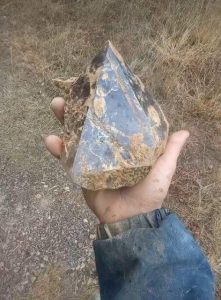
“It’s rare to have a situation like this, but there are others,” said Catherine McRae, public affairs officer for the Beaverhead-Deerlodge National Forest. The Emerald Creek Garnet Area in Idaho and Crater of Diamonds State Park in Arkansas are similar sites.
Senn commented on how there was drilling done in the area decades ago. “They found quartz and amethyst as far down as 80 feet deep,” he said, which means prospecting within this mountainside intrusion can likely continue for many years to come.
An Opportunity for Everyone
McRae said there are several specific types of folks who visit Crystal Park, Montana. Many are hardcore enthusiasts with very specific ideas of what they want to find. On the other end of the spectrum are families with children or people who are not physically able to dig in more remote areas.
“You have people who have never done (rockhounding) before,” she said.
Easy Digging & Lots of Room
Senn said, “It’s rather easy digging. You’re digging through decomposed granite.” He said kids love to find the floater crystals that weather out of the natural veins and into the topsoil making them easy to spot, especially after a good rain. “Anybody with any level of capacity of rock hounding can succeed.”
Over the 220 acres within the park, there is plenty of room to search for these stones. Senn said, “There’s a nice paved pathway that encircles the park.” From here, people are permitted to use hand tools to dig within the boundary of the park.
Senn recommends bringing a shovel, or shovels, and a screen. “It’s just moving and sifting dirt,” he said.
When it comes to removing the crystals from the soil, Senn said. ”I recommend chopsticks because they don’t hurt the crystals.”
Crystal Variety
The variety of shapes, colors and sizes of the crystals brings people back season after season because there is always something new to find. Expect to find clear quartz, sometimes with intrusions of minerals or water, along with the gray smoky quartz, or light to deep purple amethyst specimens. Sizes might be as slender as a pinky finger or something that requires two hands.
“When I was little, and even to this day, I’ve seen quartz as large as grapefruit,” said Senn who discovered his find a mere six inches below the surface. “It was really, really fun.”
The beauty of Crystal Park, Montana, on the geological front is it goes beyond simply quartz and amethyst. It’s a teaching tool to better understand the formation of the earth. “I never go up there to collect,” said Thomas. “I look for the rocks that are still intact to show how crystals grow in those spaces.”
Thomas also noted that sometimes the crystals have an orange hue, which is from groundwater that is rich in iron. He said it’s removable with a mild acid. Many rockhounds soak the crystals in citric acid or oxalic acid to remedy the discoloration without harming the stone.
Preparing for a Day of Digging
Not surprisingly, the popularity of Crystal Park, Montana continues to rise. Senn commented that during the summer hundreds of people visit every day.
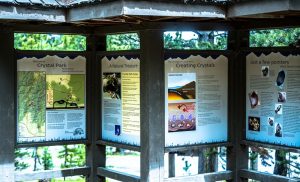
“We’re getting pretty big for her britches,” said McRae. She said there are two parking lots, which are full to overflowing on the weekends during the summer. People park along the narrow Pioneer Scenic Byway, and it’s not uncommon to find themselves stuck. It is a solid hour and a half away from help, but without cell service in the area, it might take considerable time to even call a tow truck.
The fee to visit Crystal Park is $5 per day, per person. Children younger than 10 are free. This helps provide funding to continue improvements and maintenance. While it’s a self-serve system, they do have a host on site during the summer to make sure everyone is supporting the park. Cat said they’ve already noticed improvement with people paying the fees and also digging responsibly.
While there are vault toilets and a couple of hand pumps for potable water, Senn recommended bringing everything you’re going to need for the day and planning on packing out all of your trash. “Pack it in, pack it out,” he said.
It’s also good to note that this is a prime area for wildlife, including the occasional grizzly, so it’s important to be “bear aware” and practice proper food storage practices, such as not tossing an apple core into the brush or leaving any food behind. And during the summer, the reputation for voracious mosquitoes means you must be prepared with bug spray and even netting to have a more pleasant experience.
Being Loved to Death
The long-term viability of the site as a recreation area completely depends on the public. “The Forest Service has clearly posted rules,” said Senn. “Always fill in your hole when you’re done. Don’t tunnel, don’t dig under the trees and don’t undermine pathways. But a lot of people just aren’t following them. If it becomes a greater cost (to maintain the recreational site), the only logical solution is to shut it down.”
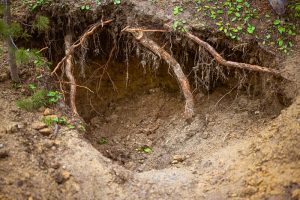
But nobody wants it to come to that, particularly the managers who love the area as much as those who visit it. “The takeaway is not to get what you can while you can,” said McRae, as they continually focus on efforts to maintain the quality of the resource.
Unfortunately, many people do not fill in their holes, and some focus on digging underneath the paved pathway or below trees, despite the rules against it. McRae said there seems to be a perception that this is where the best crystals are found, even though it’s far from reality.
Bulldozing to Fix Erosion
“Usually every three-ish years we take a dozer and create berms to dissuade the runoff,” said Torgerson. In 2022, they closed the area for a few days to backfill holes, handle hazardous trees and reclaim the area.
He said that exploring the park after the dozer work is a great opportunity because it brings up new dirt. “But about a month and a half after dozing the area you can’t even tell (that we did any work),” he pointed out. Looking like a prairie dog town along the hillside, people with shovels are back at work.
“We can’t control the popularity,” said McRae, but their goal is to manage the site for the enjoyment of everyone. She said they are working with the University of Montana Western to establish a long-term management plan for Crystal Park. One option is dividing the space and resting certain areas for a season to restore the vegetation in these hard-used places.
Cat also noted that they’re working on kiosks with video explanations of the geology and the uniqueness of this area to enhance the experience. “We’re heading in a positive direction,” she noted.
Crystal Park, Montana, is a jewel in the already stunning Pioneer Mountains that provides a rare opportunity for anyone to discover treasure. It’s up to all of us to preserve this resource so future rockhounds can share the same experiences.
This story about Crystal Park, Montana previously appeared in Rock & Gem magazine. Click here to subscribe. Story and photos by Amy Grisak.




